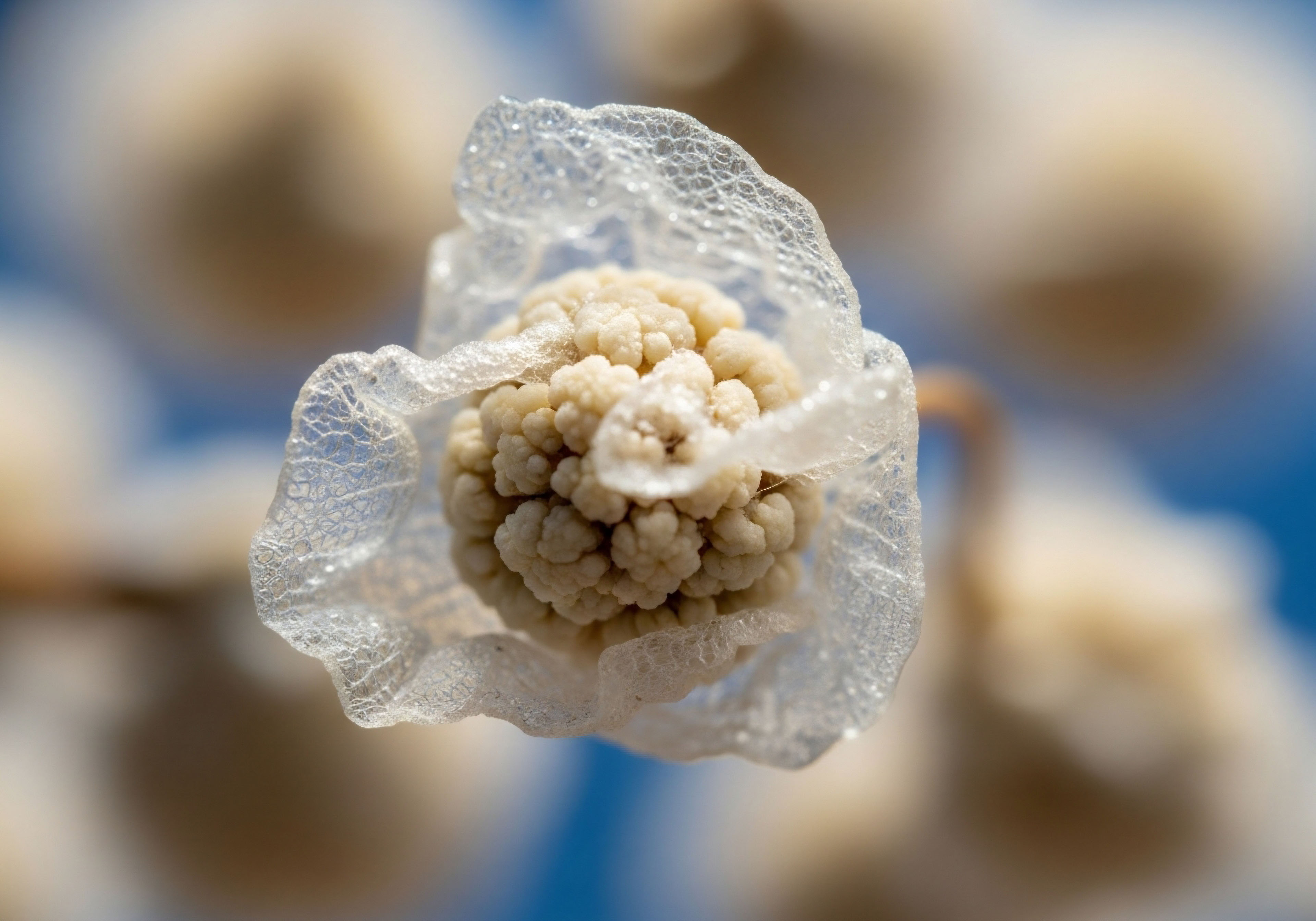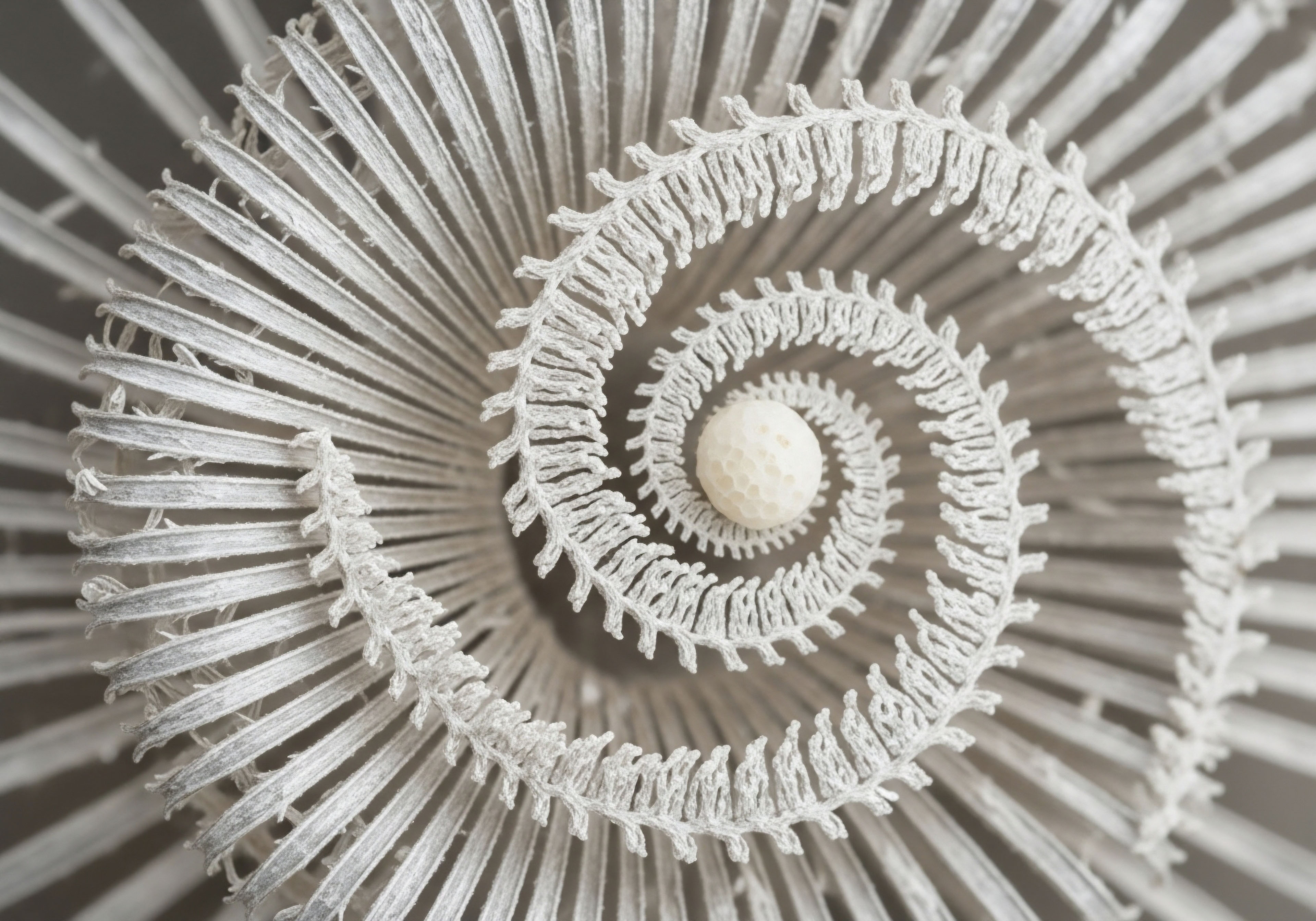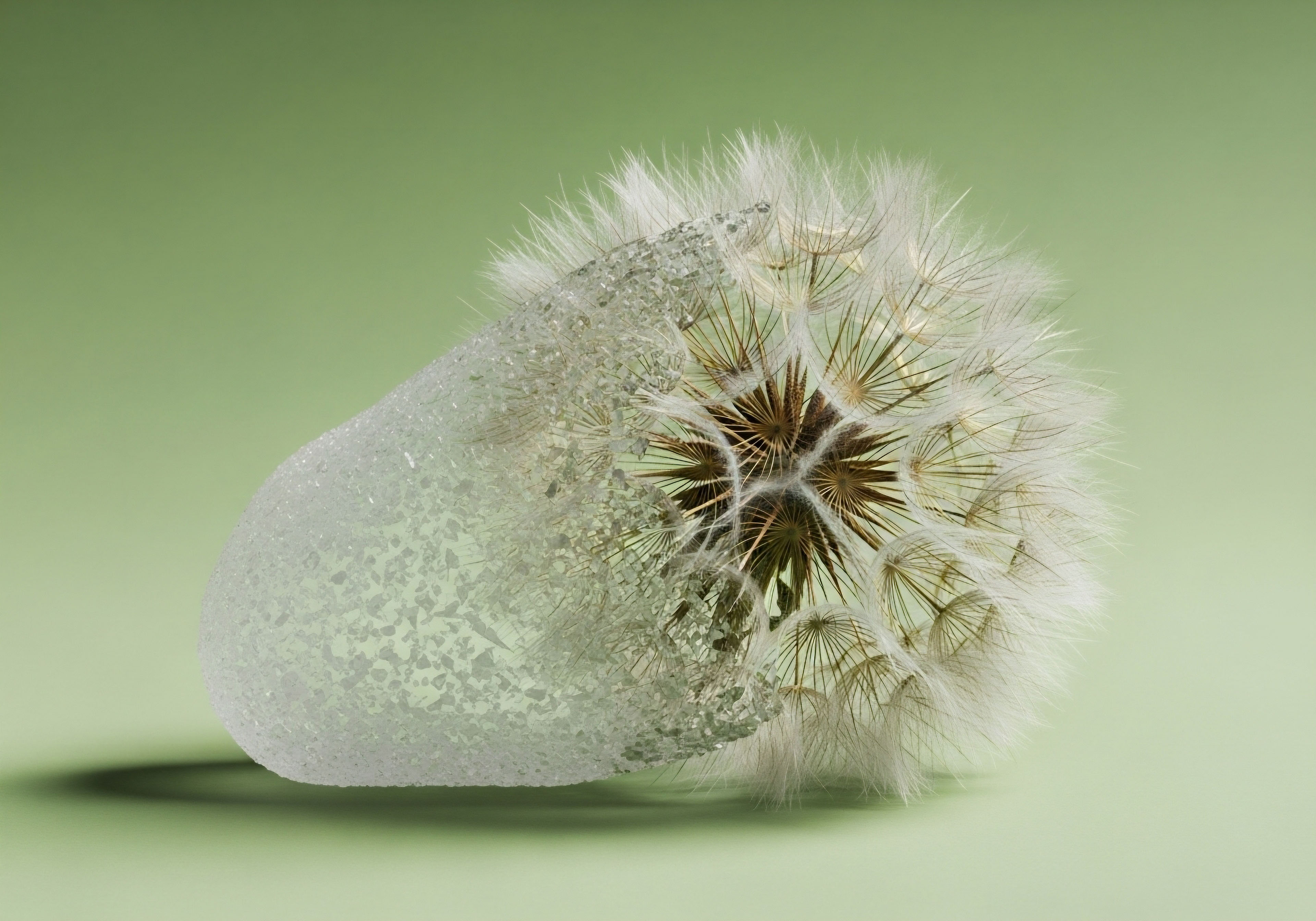

Fundamentals
The decision to consider a hormonal optimization protocol begins with a deeply personal recognition. It often starts with a quiet, persistent feeling that your internal landscape has shifted. Perhaps it’s a fatigue that sleep doesn’t resolve, a subtle decline in mental clarity, or a sense that your body’s vitality has diminished.
This experience is the first and most valid piece of data. Your lived reality is the starting point for understanding the intricate communication network within you ∞ the endocrine system. This system functions as your body’s internal messaging service, using hormones as chemical signals to coordinate everything from your energy levels and mood to your metabolic rate and reproductive capacity.
The safest way to approach an HRT lifestyle is to view it as a process of biological restoration, not just replacement. It is a meticulous collaboration with your body’s innate intelligence. The objective is to support and recalibrate the sophisticated feedback loops that govern your well-being.
At the heart of this regulation for both men and women is a powerful biological command structure known as the Hypothalamic-Pituitary-Gonadal (HPG) axis. Think of this as the central governing body for your hormonal health. The hypothalamus, a small region in your brain, senses your body’s needs and sends signals to the pituitary gland.
The pituitary, in turn, releases its own messenger hormones that travel to the gonads (the testes in men and ovaries in women), instructing them on how much testosterone, estrogen, and progesterone to produce. This entire system operates on a sensitive feedback mechanism, much like a thermostat regulating a room’s temperature, to maintain a precise balance.
A safe hormonal journey begins with understanding your body’s own communication systems before attempting to modify them.
When this communication falters, whether due to age, stress, or other physiological factors, the symptoms you feel are the direct result. The goal of a thoughtfully designed protocol is to gently and precisely correct these signaling errors. It requires a detailed map of your unique hormonal terrain, obtained through comprehensive laboratory testing.
This data provides the objective counterpart to your subjective experience, allowing for a targeted approach that respects the complexity of your individual physiology. This method provides a path toward reclaiming function and vitality by working in concert with your biological systems.

What Is the Foundation of Hormonal Assessment?
The initial step in any hormonal optimization journey is a comprehensive diagnostic evaluation. This process moves beyond a single data point to create a detailed picture of your endocrine function. It involves a series of blood tests that measure not just the primary sex hormones but also the pituitary signals that control them and other related biomarkers.
For men, this typically includes measuring total and free testosterone, Luteinizing Hormone (LH), Follicle-Stimulating Hormone (FSH), and estradiol. For women, the panel is often broader, assessing estradiol, progesterone, testosterone, DHEA-S, and the pituitary hormones LH and FSH to understand where she is in her menopausal transition.
These tests provide a quantitative baseline, a clear picture of how your HPG axis is currently functioning. This objective information, when paired with your personal experience of symptoms, creates a complete diagnostic picture that forms the bedrock of a safe and effective protocol.


Intermediate
Understanding the foundational principles of endocrine health allows for a more detailed examination of specific clinical protocols. These protocols are designed to restore hormonal balance by addressing deficiencies and optimizing the body’s signaling pathways. The methodologies differ between men and women, reflecting their distinct physiological needs, yet the underlying principle of safe application remains the same ∞ precision, personalization, and continuous monitoring.
An effective protocol is a dynamic process, adjusted over time based on follow-up lab work and your evolving symptomatic response. It is a partnership between you and your clinician, aimed at achieving a state of sustained well-being.

Protocols for Male Endocrine System Support
For men experiencing the effects of low testosterone (hypogonadism), a standard therapeutic approach involves Testosterone Replacement Therapy (TRT). A common and effective protocol uses weekly intramuscular injections of Testosterone Cypionate, a bioidentical form of testosterone. The goal is to restore serum testosterone levels to a healthy, youthful range, thereby alleviating symptoms like low energy, reduced muscle mass, and diminished libido.
This intervention, however, must account for the body’s HPG axis feedback loop. The introduction of external testosterone signals the pituitary gland to reduce its production of LH and FSH. This down-regulation can lead to testicular shrinkage and a halt in the body’s own testosterone production.
To address this, a comprehensive protocol includes adjunctive therapies. Gonadorelin, a synthetic form of Gonadotropin-Releasing Hormone (GnRH), is administered via subcutaneous injections. It directly stimulates the pituitary gland to continue releasing LH and FSH, thereby maintaining testicular function and size even while on TRT. Another key component is managing estrogen levels.
As testosterone levels rise, some of it naturally converts to estradiol via the aromatase enzyme. To prevent an unhealthy imbalance, a medication like Anastrozole, an aromatase inhibitor, is often prescribed. This integrated approach ensures that the therapy is holistic, supporting the entire endocrine system rather than just elevating a single hormone.
Effective hormonal therapy for men addresses testosterone levels while actively preserving the natural function of the HPG axis.

Table of Male TRT Protocol Components
The following table outlines the standard components of a well-structured TRT program, detailing the function and purpose of each medication within the system.
| Component | Mechanism of Action | Primary Purpose in Protocol |
|---|---|---|
| Testosterone Cypionate | Directly replaces testosterone, binding to androgen receptors throughout the body. | To restore serum testosterone to optimal levels and resolve symptoms of hypogonadism. |
| Gonadorelin (GnRH) | Stimulates the pituitary gland to produce Luteinizing Hormone (LH) and Follicle-Stimulating Hormone (FSH). | To prevent testicular atrophy and maintain the body’s natural hormone production pathways. |
| Anastrozole | Inhibits the aromatase enzyme, reducing the conversion of testosterone to estradiol. | To control estrogen levels, preventing side effects associated with estrogen dominance. |
| Enclomiphene | A selective estrogen receptor modulator (SERM) that can also stimulate the pituitary to release LH and FSH. | Used as an alternative or adjunct to support natural testosterone production, particularly in men concerned with fertility. |

Protocols for Female Endocrine System Support
Hormonal support for women, particularly during the perimenopausal and postmenopausal phases, involves a delicate recalibration of multiple hormones. While estrogen and progesterone replacement are well-established, there is growing clinical recognition of the role testosterone plays in female vitality, libido, and overall well-being.
A meta-analysis of studies has shown that testosterone therapy can significantly improve sexual function in postmenopausal women. The Endocrine Society has issued guidelines that, while cautious, acknowledge the evidence for testosterone’s efficacy in treating hypoactive sexual desire disorder.
A typical protocol for women involves very low doses of Testosterone Cypionate, often administered weekly via subcutaneous injection. These doses are a fraction of what is used for men and are designed to bring a woman’s testosterone levels back to the higher end of her normal physiological range.
This therapy is frequently combined with progesterone, which is essential for uterine health in women who have not had a hysterectomy and also contributes to mood stability and sleep quality. The goal is to create a synergistic effect, where the hormonal milieu is balanced as a whole, leading to a comprehensive improvement in symptoms from hot flashes and mood swings to low energy and libido. Careful monitoring for any signs of androgen excess is a fundamental aspect of ensuring safety.
- Testosterone Cypionate ∞ Administered in small, precise weekly doses (e.g. 0.1 ∞ 0.2ml) to restore libido, improve energy, and enhance mood and cognitive clarity.
- Progesterone ∞ Prescribed cyclically or continuously, depending on menopausal status, to balance estrogen and provide calming, pro-sleep benefits.
- Pellet Therapy ∞ An alternative delivery method involving the subcutaneous implantation of long-acting testosterone pellets, which can provide stable hormone levels for several months.

The Role of Growth Hormone Peptides
Beyond the primary sex hormones, a comprehensive approach to wellness can include therapies that support other endocrine pathways. Growth Hormone Peptide Therapy is an advanced strategy used to encourage the body’s own production of human growth hormone (HGH). Peptides like Sermorelin and Ipamorelin are secretagogues, meaning they signal the pituitary gland to release HGH.
Sermorelin is an analog of Growth Hormone-Releasing Hormone (GHRH), while Ipamorelin mimics ghrelin to stimulate HGH release through a different but complementary pathway. These therapies are often used to improve body composition, enhance recovery from exercise, deepen sleep quality, and support overall cellular repair.
They represent a more subtle approach than direct HGH injections, as they work by stimulating the body’s natural pulsatile release of growth hormone, preserving the integrity of the feedback loops within the Hypothalamic-Pituitary-Somatotropic axis.


Academic
A sophisticated understanding of hormonal optimization requires a deep investigation of the body’s primary regulatory architecture, the Hypothalamic-Pituitary-Gonadal (HPG) axis. The safety and efficacy of any hormonal intervention are directly proportional to how well that intervention respects the intricate, bidirectional communication within this system.
Exogenous hormone administration, particularly of testosterone, fundamentally alters the homeostatic balance of the HPG axis through a process of negative feedback inhibition. This biological reality necessitates the use of advanced, multi-faceted clinical strategies designed to support, rather than simply override, endogenous function. The safest approach is one grounded in the principles of physiological restoration and systemic equilibrium.

HPG Axis Modulation in Androgen Therapy
When a male is administered exogenous testosterone, the hypothalamus and pituitary gland sense the elevated serum androgen levels. This perception triggers a down-regulation of endogenous Gonadotropin-Releasing Hormone (GnRH) from the hypothalamus. Consequently, the pituitary gland reduces its pulsatile secretion of Luteinizing Hormone (LH) and Follicle-Stimulating Hormone (FSH).
LH is the primary signal for the Leydig cells in the testes to produce testosterone, while FSH is critical for spermatogenesis. The cessation of these trophic signals leads to a decline in intratesticular testosterone concentrations and testicular volume, a clinical outcome that can be distressing for patients and impact fertility.
The integration of Gonadorelin into a TRT protocol is a direct application of endocrinological principles to mitigate this effect. Gonadorelin is a GnRH analog that binds to receptors on the pituitary gonadotropes, initiating the synthesis and secretion of LH and FSH.
By administering it in a manner that mimics the body’s natural pulsatile rhythm, it is possible to maintain the integrity of the pituitary-gonadal connection, preserving testicular function and steroidogenesis. Long-term studies on TRT have shown that with proper management, risks can be effectively managed, and concerns about cardiovascular events or prostate cancer have not been substantiated in well-controlled clinical settings.
True hormonal mastery lies in modulating the body’s regulatory axes, not just supplementing the end-product hormones.

How Do Hormone Therapies Affect Cellular Mechanisms?
Hormones exert their effects by binding to specific receptors at the cellular level, initiating a cascade of downstream signaling events that alter gene expression and cellular function. Testosterone, for instance, binds to androgen receptors in muscle cells, promoting protein synthesis and hypertrophy. In fat cells, it can influence lipid metabolism.
Estradiol, produced from the aromatization of testosterone, has its own set of critical functions, binding to estrogen receptors to regulate bone density, cardiovascular health, and cognitive function. The goal of a well-calibrated hormonal protocol is to achieve an optimal balance of receptor activation across these different tissues.
Anastrozole’s role is to modulate the activity of the aromatase enzyme, thereby controlling the ratio of testosterone to estradiol and ensuring that the signaling benefits of both hormones are realized without the detrimental effects of excessive estrogen receptor activation in male tissues.

Table of HPG Axis Hormones and Therapeutic Modulators
This table details the key hormones of the Hypothalamic-Pituitary-Gonadal axis and the pharmacological agents used to modulate their activity within a therapeutic context.
| Hormone / Agent | Origin / Class | Primary Physiological Function or Therapeutic Action |
|---|---|---|
| GnRH | Hypothalamus | Stimulates the pituitary to release LH and FSH. |
| LH | Pituitary Gland | In men, stimulates testosterone production. In women, triggers ovulation. |
| FSH | Pituitary Gland | In men, supports spermatogenesis. In women, supports ovarian follicle growth. |
| Testosterone | Gonads / Adrenals | Primary male androgen; critical for muscle mass, bone density, libido, and energy. |
| Estradiol | Gonads / Adipose Tissue | Primary female estrogen; in men, crucial for bone, joint, and cognitive health. |
| Gonadorelin | GnRH Analogue | Therapeutically mimics GnRH to maintain pituitary output of LH and FSH during TRT. |
| Anastrozole | Aromatase Inhibitor | Blocks the conversion of testosterone to estradiol, used to manage estrogen levels. |

Peptide Science and Growth Hormone Axis
A parallel field of study involves the modulation of the Growth Hormone (GH) axis using peptide secretagogues. These compounds represent a sophisticated approach to enhancing tissue repair, metabolic function, and body composition. Peptides like Sermorelin, a GHRH analog, and Ipamorelin, a selective ghrelin receptor agonist, stimulate the pituitary to release GH in a pulsatile manner that mirrors natural physiology.
This method is distinct from the administration of recombinant HGH (rHGH), as it preserves the integrity of the negative feedback loop involving somatostatin. Research indicates these peptides can increase GH and IGF-1 levels, leading to improvements in lean body mass and reductions in adipose tissue. Their selectivity and mechanism of action, which up-regulates the body’s own production machinery, present a favorable safety profile for long-term wellness strategies.
- Sermorelin ∞ A GHRH analog that directly stimulates the GHRH receptor on the pituitary, promoting the release of GH. It has been shown to increase lean body mass.
- Ipamorelin/CJC-1295 ∞ Ipamorelin is a selective GH secretagogue that activates the ghrelin receptor, while CJC-1295 is a long-acting GHRH analog. The combination provides a potent, synergistic stimulus for GH release with minimal impact on other hormones like cortisol.
- Tesamorelin ∞ A stabilized GHRH analog specifically studied and approved for reducing visceral adipose tissue in certain populations, highlighting the targeted metabolic benefits of these therapies.

References
- Wierman, M. E. et al. “Androgen therapy in women ∞ a reappraisal ∞ an Endocrine Society clinical practice guideline.” Journal of Clinical Endocrinology & Metabolism, vol. 99, no. 10, 2014, pp. 3489-3510.
- “Gonadorelin for Men on Testosterone Replacement Therapy (TRT).” Defy Medical, Accessed July 2024.
- “Maximizing Male Health ∞ TRT and Gonadorelin Synergy Explained.” IAM Clinic, Accessed July 2024.
- Sigalos, J. T. & Pastuszak, A. W. “Beyond the androgen receptor ∞ the role of growth hormone secretagogues in the modern management of body composition in hypogonadal males.” Translational Andrology and Urology, vol. 7, no. 1, 2018, pp. 89-95.
- Islam, R. M. et al. “Safety and efficacy of testosterone for women ∞ a systematic review and meta-analysis of randomised controlled trial data.” The Lancet Diabetes & Endocrinology, vol. 7, no. 10, 2019, pp. 754-766.
- Corona, G. et al. “Testosterone Replacement Therapy ∞ Long-Term Safety and Efficacy.” Expert Opinion on Drug Safety, vol. 16, no. 11, 2017, pp. 1-13.
- Stuenkel, C. A. et al. “Treatment of Symptoms of the Menopause ∞ An Endocrine Society Clinical Practice Guideline.” Journal of Clinical Endocrinology & Metabolism, vol. 100, no. 11, 2015, pp. 3975-4011.

Reflection
The information presented here offers a map of the biological terrain you inhabit. It details the communication networks, the chemical messengers, and the clinical strategies that can be used to restore balance and function. This knowledge is a powerful tool, shifting the perspective from one of passive suffering to one of active, informed participation in your own health.
The path forward involves taking this understanding and applying it to your unique situation. Your personal biology, your history, and your goals are the defining elements of your journey. The safest and most effective path is always one that is built upon a foundation of deep self-knowledge and guided by expert clinical partnership. The potential to reclaim your vitality is inherent within your own physiology.

Glossary

endocrine system

pituitary gland

hpg axis

testosterone replacement therapy

testosterone cypionate

gonadorelin

testosterone levels

anastrozole

growth hormone peptide therapy

growth hormone

ipamorelin

sermorelin

metabolic function




